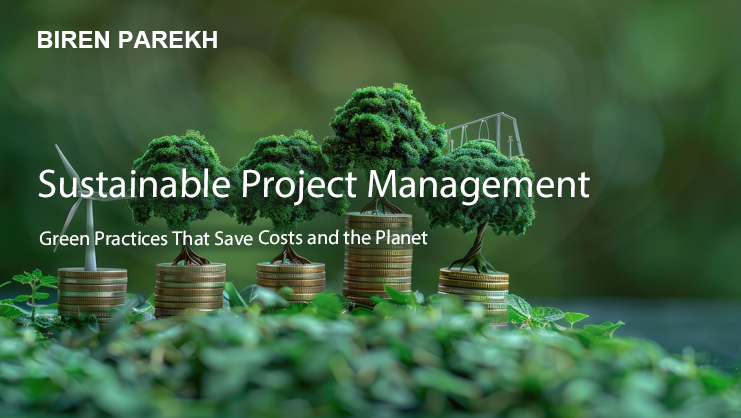
Have you ever thought about how project managers can save money while protecting the environment? Green project management is the answer. It’s an approach that helps organizations achieve project goals efficiently while minimizing environmental impact. More companies are adopting sustainable project management practices to reduce waste, optimize resources, and align with ESG goals all while cutting costs.
What is Green Project Management?
Green project management integrates environmental responsibility into every stage of a project from planning and execution to monitoring and closure. Unlike traditional project management, which focuses on time, cost, and quality, green project management prioritizes sustainability alongside project performance.
Using green project management techniques, organizations can:
- Minimize energy consumption
- Reduce material waste
- Implement eco-friendly procurement strategies
- Ensure alignment with ESG goals
A well-structured sustainability management plan guides project managers in embedding these practices seamlessly into their workflows, creating long-term benefits for both the organization and the planet.
Core Principles of Sustainable Project Management
Adopting sustainable project management requires a commitment to a few key principles:
- Resource Efficiency – Optimize the use of materials, energy, and human resources to reduce costs and environmental impact. Examples include using energy-efficient equipment and reusing materials whenever possible.
- Waste Reduction – Implement digital documentation, recycle materials, and manage project waste to reduce environmental harm.
- Life Cycle Thinking – Consider the environmental impact of a project from start to finish. Life cycle assessment identifies areas where green project management techniques can be applied.
- Stakeholder Engagement – Involve team members, suppliers, and clients in sustainability initiatives. Clear communication ensures everyone is aligned with the project’s environmental objectives.
Green Project Management Techniques
Practical green project management techniques make sustainability actionable. These include:
- Energy-Efficient Project Planning: Schedule activities to reduce energy use and optimize work patterns.
- Sustainable Procurement: Select eco-friendly suppliers and materials that minimize environmental impact.
- Digital Collaboration: Use project management software and online tools to reduce paper usage and physical meetings.
- Monitoring and Reporting: Track environmental metrics throughout the project lifecycle to measure performance and make improvements.
Benefits of Sustainable Project Management
Implementing green project management offers both tangible and intangible benefits:
| Benefit | Description |
| Cost Savings | Efficient use of resources, energy reduction, and waste minimization lower operational costs. |
| Regulatory Compliance | Helps organizations meet environmental standards and avoid penalties. |
| Enhanced Reputation | Promotes a positive brand image, attracting clients, partners, and investors. |
| Employee Engagement | Employees are more motivated when working on projects that contribute to sustainability. |
| Alignment with ESG Goals | Supports broader corporate environmental, social, and governance objectives. |
Integrating a Sustainability Management Plan
A sustainability management plan (SMP) is essential for implementing green project management effectively. It provides a clear framework with strategies, goals, and performance indicators for sustainability. Key components of an SMP include:
- Environmental Policies – Guidelines for energy use, waste management, and resource conservation.
- Risk Assessment – Identify potential environmental risks and define mitigation strategies.
- Sustainability Targets – Set measurable objectives aligned with ESG goals.
- Continuous Monitoring – Regularly evaluate sustainability performance to ensure compliance and improvement.
By incorporating a sustainability management plan, organizations can systematize their approach to green project management and demonstrate their commitment to sustainable practices.
Challenges and How to Overcome Them
While the benefits are clear, organizations may face challenges:
- High Initial Costs – Eco-friendly materials or energy-efficient equipment may require upfront investment. Long-term savings typically outweigh initial costs.
- Resistance to Change – Team members or stakeholders may be hesitant to adopt new practices. Training, communication, and demonstrating tangible benefits can reduce resistance.
- Measuring Impact – Quantifying environmental benefits can be complex. Using sustainability metrics and reporting frameworks ensures clarity and accountability.
Steps to Implement Green Project Management
Organizations can follow these practical steps to make green project management a reality:
- Assess Current Processes – Identify areas where sustainability improvements are needed.
- Set Clear Goals – Align objectives with ESG targets and business priorities.
- Engage Stakeholders – Ensure team members, clients, and suppliers are aligned with sustainability goals.
- Apply Green Techniques – Incorporate energy-efficient planning, waste reduction, and eco-friendly procurement into projects.
- Monitor and Adjust – Track sustainability performance and refine practices for better outcomes.
The Future of Sustainable Project Management
As businesses increasingly focus on sustainability, green project management will become essential. Emerging trends include digital tools for project tracking, AI-based resource optimization, and circular economy practices. Companies that proactively implement these green strategies will reduce environmental impact while gaining a competitive edge.
Conclusion
Green project management is more than a trend, it’s a necessary approach for organizations that want to achieve project success while supporting sustainability. By using sustainable project management techniques, developing a comprehensive sustainability management plan, and aligning initiatives with ESG goals, organizations can reduce costs, meet regulatory requirements, and enhance their brand reputation.
Each step toward green project management, whether it’s optimizing resources, reducing waste, or monitoring sustainability metrics, helps businesses operate efficiently while protecting the planet. The future belongs to organizations that prioritize sustainable practices today, combining project success with environmental responsibility.





